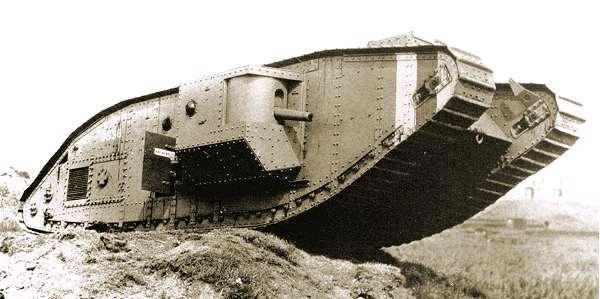The Mark V Heavy Tank was the first of the British heavy tanks to require only one driver. This was because it had a new four-speed epicyclic gearbox, which was designed by W.G. Wilson.
Other improvements included better ventilation and improved visibility for the crew.
A new 150hp Ricardo engine powered the Mark V.
While the Mark IV had only a 25 mile (40km) range, the Mark V had a much larger range of 45 miles (72.4km). Armored fuel tanks at the tail of the Mark V held 60 gallons of gasoline.
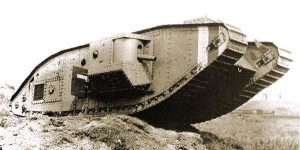
From December 1917 through June 1918, 400 Mark Vs were built, half of them male and half of them female.
Some Mark Vs, as well as some Mark IVs, had tadpole tails fitted to them. The tadpole tail was a device that was attached to the rear of the tank and made the tank about 9 feet (2.74 meters) longer. It was designed to make it easier for the tank to cross trenches. Unfortunately, tadpole tails were not rigid or laterally stable enough to be very effective.
In a version of the Mark V known as the Mark VA, 6 feet (1.83 meters) of armor were fitted between the sponson opening and the housing for the epicyclic gear. This was a better way to lengthen the tank so that it would be better at crossing trenches. Adding the extra 6 feet of armor also created extra storage space in the tank – enough to carry as many 25 men.
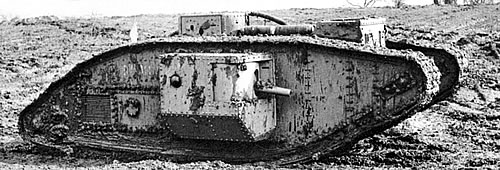
The addition of this extra armor increased the weight of the tank from 29 tons (29,465kg) to 33 tons (33,530 kg). However, the Mark VA used the same engine as the standard Mark V. Therefore, the Mark VA was slower and harder to maneuver than the standard Mark V.
The first battalion to receive the Mark V was the 8th Battalion Tank Corp, which was provided with Mark V Heavy Tank No. 9199 in July 1918.
On August 8, 1918, during the Battle of Amiens, Crew H41 of the 8th Battalion became the first men to see action in the Mark V. Tank No. 9199 remained undamaged by the end of the battle. Tank commander Lt. H.A. Whittenbury received a Military Cross for his service.
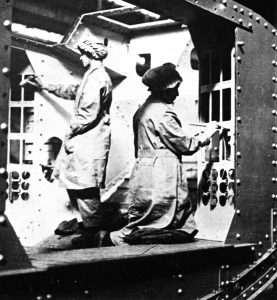
In September, Crew H41, which had a different commander by this time, led an infantry attack on the village of Estrees. Shellfire hit No. 9199 and then damaged the left track.
The tank was then used for training at Bovington, in Wareham, Dorset. In 1921, it was given to the 4th Battalion, Tank Corps at Wogret Camp, near Wareham.
It was returned to Bovington in 1925.
The Driving and Maintenance School and the Camp Workshops used Tank No. 9199 for towing and recovery during World War II.
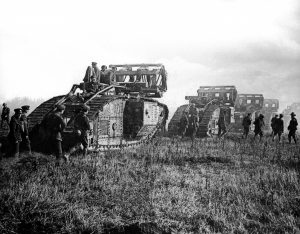
Tank No. 9199 was finally donated to the Tank Museum at Bovington in 1949.
Although the Mark V was superior to earlier tanks, it did have flaws. It was hard to drive and often broke down. In addition, the crewmen inside the tank often suffered from carbon monoxide poisoning because of poor ventilation.
Mark V Heavy Tank (Male) |
|
|---|---|
| Active: | 1918 |
| Crew: | 8 |
| Weight: | 29 tons (29,465kg) |
| Length: | 26ft 4in (8.03m) |
| Height: | 8ft 2in(2.49m) |
| Width: | 12ft 10in (3.91m) |
| Weapons: | Main – 2 x 6 pounder 2.24 in (57mm) guns, Secondary – 4 x 0.303in (7.7mm) Hotchkiss machineguns |
| Armor | Maximum – 0.47in (12mm) |
| Engine: | Ricardo 6-cylinder gasoline, 150 hp |
| Speed: | 4.6 mph (7.4 kph) |
| Range: | 45 miles (72.4 km) |
